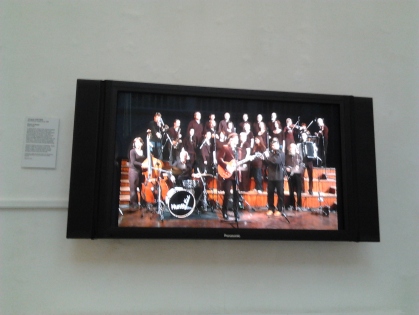Archive for April 2013
At Aberdeen Art Gallery
A recent visit to Aberdeen meant I got chance to visit Aberdeen Art Gallery, an impressive space, with an impressive collection including some contemporary works and, my particular interest: abstract paintings. The John Copnall painting Green For Cathy, 1973, looks like it was a painted especially for this space, even though it was not actually a site specific work. (There’s a better photo of it here.)
According to the label it had been included in a solo show of Copnall’s paintings at Aberdeen Art Gallery in 1974 and was purchased later that year. Set amongst other more contemporary art works here, not necessarily paintings, I think it demonstrates something of the power of formalist painting, even now, long after its ‘moment’ has supposedly passed.
Seeing it from a distance the relationship between painting and place is what I am most aware of, the painting’s verticality echoing and perhaps also competing with the architecture, such that “architectural” is an adjective for the artwork that seems difficult to resist. Getting close up, no new information is revealed in terms of detail, brush strokes for example, yet the experience is different. From here it’s me and the colour that forms the primary relationship.
Absolutely not seeing a window on the world, just me and it, my awareness of the ‘here and now’ is heightened. Here in this place the ‘now’ continues on for a while, its content remaining unchanged, leading to this stretching out of the experience. Not eternal or timeless, this ‘now’, comprised of smaller ‘now’s, each one giving way to another, also contains multiple ‘then and there’s. For example, I am remembering my brother’s criterion for a good painting: that it will continue to get better even after repeated viewings, something I learned when we were looking at a painting in the Whitworth a few weeks ago. And now I am considering whether this painting would achieve his criterion. I also find myself making comparisons with other artists, clear influences of Copnall, like Barnett Newman and Morris Louis.
Then, as I break state by starting to move away I notice an after image, my own projection on the white wall, instead of an expanse of red I see an expanse of green with narrow red black and orange stripes at the edge.
And I also realize that since stepping into the gallery I have been dimly aware of a familiar sound, emphasizing not the extended ‘now’ but its opposite, the continual repetition of beginning and ending, and especially ending. If it wasn’t that I love the song Room to Roam by Mike Scott, from the 1990 Waterboys album of the same title, I might find the constant repetition of it annoying. The song, featured in an audio visual artwork by Jacques Coetzer, stresses the word “end” in the repeated line “ending in one end” but then when it’s played on a loop that emphasis is magnified. Even when you are not looking at the piece it can be heard all around the gallery. And it doesn’t end there, it continues to repeat in my head long after the gallery visit is over.
I do enjoy the video, and the associations it has for me, remembering that when that album was first released my friend bought a copy on the strength of hearing the Waterboys earlier Album This is the Sea, which includes the amazing song The Whole of the Moon. I had lent my copy to him and he liked it so much that he went out and bought the new Album, only to find that he hated it, so he gave it to me, (thanks Simon).
Painting is less intrusive, it can more easily be ignored, and recollecting a painting afterwards I tend to find more difficult than with a song. But despite the pleasure I gain from the audio/video, it is the paintings that really interest me, the Copnall on one side of the Coetzer, and Rumbold Vertical Four: Green in Green with Blue and Red, 1970 by Patrick Heron on the other side. (A better photo here.)
Like Green for Cathy its verticality seems particularly right for this place, almost like the venue requires a strong visual statement. The two paintings look good together, sharing similar themes: an expanse of colour bordered by stripes on the right hand edge, Copnall’s stripes being more ‘optical’ and Heron’s more wobbly. (Didn’t he once refer to his paintings as “Wobbly hard edge”?) In this informal series Heron combines the stripe with positive/negative circular motifs that look like cut outs. Figure ground relationships shift and colours that ‘should’ recede (e.g. blue) seem to project forward. He seems also play with the idea of ‘on’ versus ‘in’.




